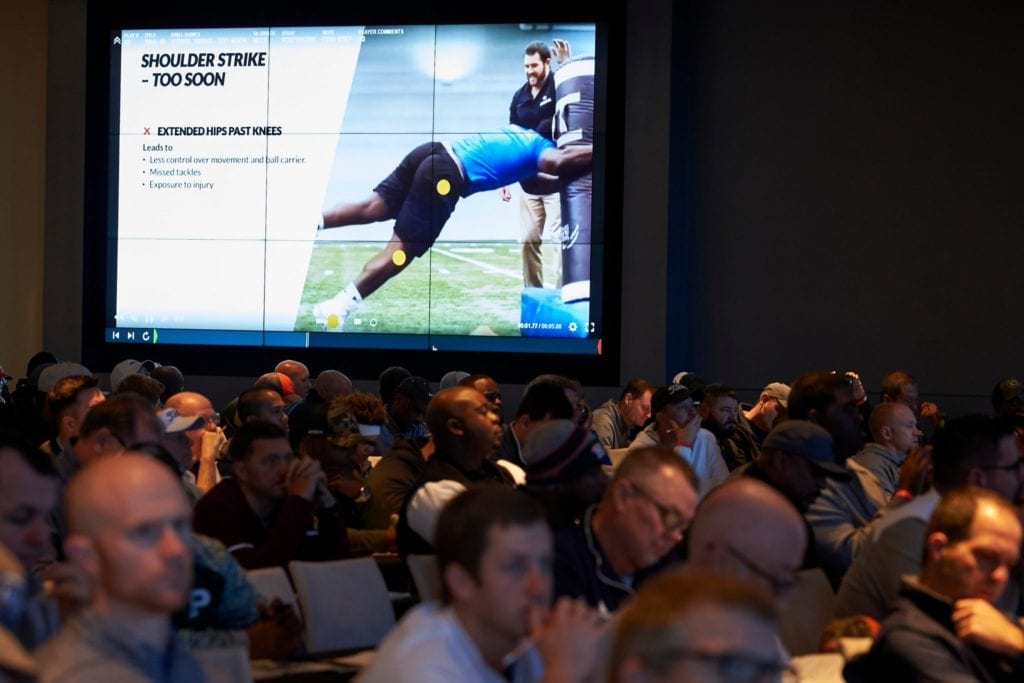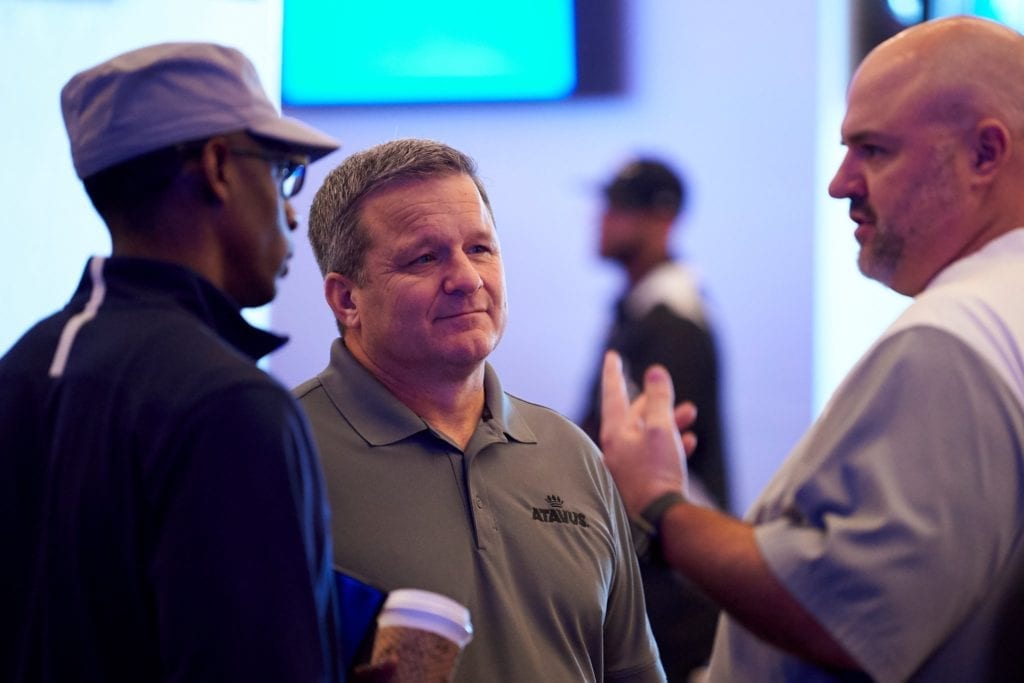
The New York Times, Jan. 2nd 2019
| ARLINGTON, Tex. — Raymond Kitchen had other places he would rather have been than in a big, empty football stadium at 7 a.m. on a Saturday. But there he was, three days before Christmas, with 450 other high school football coaches, attending a two-hour lecture on tackling at AT&T Stadium, the home of the Dallas Cowboys. The lecture was a part of an ambitious effort to have all of the state’s 23,000 junior high and high school football coaches become familiar with, by August, a program that teaches rugby-style tackling. It emphasizes the use of the shoulder, not the head, in bringing down the player with the ball. The program was created by Atavus, a company based in Seattle that says it can produce more effective tacklers by teaching defenders to square up before hitting a ball carrier and to use their shoulders and legs for leverage and power. Coaches like Kitchen seem receptive to the message Atavus is trying to popularize. “It’s where to put your head that is the focus now,” Kitchen, a defensive coach at James Bowie High School, in Arlington, said after he finished a written test that was a part of the certification. “Every year, with C.T.E., every coach is now, ‘Get your head out of it,’” he added, using the initialism for chronic traumatic encephalopathy, a degenerative brain disease linked to repeated hits to the head. |

From the viewpoint of the Texas High School Coaches Association, any program that might reduce the number of head injuries in football, and the apprehension that they create, is worth looking at. Even if the program is inspired by a sport, rugby, that is much more prominent in other parts of the world than it is in the United States.
After all, while participation in high school football in Texas has remained relatively steady over the past decade, the game is not growing here as fast as it once was. In part, that is because of specialization, which has locked some children into other sports. But another factor is the concern by a growing number of parents that football is simply too dangerous.
That concern was clearly a part of the narrative at the seminar. Over and over, coaches who were present said the game was “under attack,” even in Texas, where football is nearly a religion. And to a man, they insisted that the benefits of the game — which they maintain teaches grittiness and teamwork — far outweighed its risks.
“The most important part of it is getting moms to realize that the game is safer than it probably ever has been because of coaches’ awareness of concussions and all the things we’re trying to teach them, and because of the tackling training that’s coming on board,” said D.W. Rutledge, the outgoing executive director of the Texas High School Coaches Association.
Rutledge and the coaches association have tried to reassure skittish parents by adopting rules that govern when players can return to action after a concussion and also limit the number of full-contact practices. Now they have turned to the rugbystyle tackling program in their latest, and perhaps most elaborate, attempt to convince skeptics that football can be made safer to play.
Rutledge and his second-in-command, Joe Martin, started searching for tackling programs about two years ago, concerned that state legislators might call for further restrictions on the sport. The most well-known tackling program was one designed by U.S.A. Football, which is funded by the N.F.L. But its emphasis was primarily on youth football.
Rutledge and Martin wanted something that addressed older and more powerful athletes, and they were impressed with Atavus because of the dozens of techniques it uses to teach defenders how to approach ball carriers and bring them down.
Pete Carroll, the coach of the Seattle Seahawks, has promoted “hawk tackling,” which borrows heavily from rugby. But Atavus, which works with coaches at Ohio State, Michigan State, Rutgers and other colleges, also uses video to analyze and rate tackles as well as identify additional drills to address deficiencies.
In seizing on rugby as a model, Atavus was choosing to highlight a sport in which tackling above the shoulder is not permitted; some players wear “scrum caps’’ but none wear the hard plastic helmets used in football; and the rate of concussions is lower than in football, according to Dawn Comstock, a sports injury epidemiologist at the Colorado School of Public Health.
Rex Norris, a former football coach in Texas who helped develop the tackling program for Atavus, which is called Tacklytics, knew that some coaches might be suspicious of techniques borrowed from rugby, and consider them an attempt to soften the way football is played, even though rugby is a physical sport played by burly athletes. So he started his hourlong presentation last month with a blunt proclamation:
“We believe in tackling the legs,” he told the coaches. “We believe in body-on-body contact. And we believe in knocking the runner backward. We know how much this game is changing, and as coaches, we have to continue to change. We have to continue to change how we think, about how we practice.”
Norris spoke to the coaches as a peer. But a part of him was akin to a physics professor trying to translate complex equations into simple concepts. Being an effective tackler, he told those at the seminar, was not just about bringing down a ball carrier, but about maximizing one’s power and control. To tackle effectively, a defender must take the right angle to the ball, face the ball carrier and use his legs, hips and shoulder in concert.
“It’s not how fast you are coming, but if you are under control,” he said.
Common sense suggests that avoiding head hits will reduce concussions and curtail the many smaller impacts with the helmet that have also been linked to long-term brain disease. One of the effective ways to do that is limiting the number of fullcontact practices, something promoted by groups like Practice Like Pros, which partners with Atavus.
But the link between concussions in football and tackling programs that reduce exposure to the head is far from established. For example, U.S.A. Football walked back a study it released about how its Heads Up Football program had helped reduce concussions on the youth level.
And one of the difficulties in designing rigorous studies is establishing just what led to players’ concussions. They can get concussions for other reasons — such as hitting their head on the turf — that have nothing to do with tackling the ball carrier.
Art Maerlender, the director of clinical research at the Center for Brain, Biology and Behavior at the University of Nebraska, in Lincoln, and a medical adviser to Atavus, said he was developing a “more fine-grained analysis” to account for all the variables that can lead to a concussion.
Still, he noted, “just reducing the amount of times you hit your head makes sense,” he said. He also said that from his perspective, “this focus on technique is really quite new in American football.’’
At least anecdotally, the Atavus tackling technique appears to help. Rodney Webb, the head coach at Rockwall High School, about a half-hour’s drive from Dallas, started using the program in 2016. While his players quickly learned the drills in practice, their results during games did not improve until the second season. In the season and a half since then, the number of missed tackles fell 30 percent during games, Webb said, and his varsity team had no concussions in the most recent season.
“When it comes to tackling, it is a safer practice and a better practice,” he said of the rugby-style technique. “It’s a win-win.”
As in Texas, many states have introduced return-to-play guidelines following concussions, and have limited the number of full-contact practices. Some of those states are now looking at how the tackling-technique program is taking hold in Texas. Representatives from high school football coaches associations in Alabama, Georgia and Oklahoma, among others, have spoken to Rutledge and Martin about their experience with Atavus.
Meanwhile, U.S.A. Football is beginning to promote its own rugby-style tackling program. But whether any program can reverse the tide of players joining other sports is another question. Coaches know that parental skepticism can run deep, even in Texas.
“I’m not the first one to say it, but football is dead in 15 years because mama doesn’t want her kids to play the game,” said Jim McDougle, an offensive coordinator at Bryan Adams High School in Dallas. “You can be as safe as you want to be, but it’s still a violent sport.”